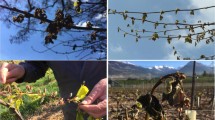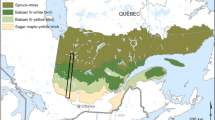Abstract
The length of the snow-free season is a key factor regulating plant phenology and shaping plant community composition in cold regions. While global warming has significantly advanced the time of snowmelt and the growth period at all elevations in the Swiss Alps, it remains unclear if it has altered the likelihood of frost risk for alpine plants. Here, we analyzed the influence of the snowmelt timing on the risk of frost exposure for subalpine and alpine plants shortly after snowmelt, i.e., during their most vulnerable period to frost at the beginning of their growth period. Furthermore, we tested whether recent climate warming has changed the risk of exposure of plants to frost after snowmelt. We analyzed snow and air temperature data in the Swiss Alps using six weather stations covering the period 1970–2016 and 77 weather stations covering the period 1998–2016, spanning elevations from 1418 to 2950 m asl. When analyzed across all years within each station, our results showed strong negative relationships between the time of snowmelt and the frequency and intensity of frost during the most vulnerable period to frost for subalpine and alpine plants, indicating a higher frost risk damage for plants during years with earlier snowmelt. However, over the last 46 years, the time of snowmelt and the last spring frost date have advanced at similar rates, so that the frequency and intensity of frost during the vulnerable period for plants remained unchanged.





Similar content being viewed by others
References
Ahas R, Aasa A, Menzel A, Fedotova V, Scheifinger H (2002) Changes in European spring phenology. Int J Climatol 22:1727–1738
Bannister P (2007) Godley review: a touch of frost? Cold hardiness of plants in the southern hemisphere. N Z J Bot 45:1–33
Bannister P, Maegli T, Dickinson KJ, Halloy SR, Knight A, Lord JM, Mark AF, Spencer KL (2005) Will loss of snow cover during climatic warming expose New Zealand alpine plants to increased frost damage? Oecologia 144:245–256
Carlson BZ, Corona MC, Dentant C, Bonet R, Thuiller W, Choler P (2017) Observed long-term greening of alpine vegetation—a case study in the French Alps. Environ Res Lett 12:114006
Gerdol R, Siffi C, Iacumin P, Gualmini M, Tomaselli M (2013) Advanced snowmelt affects vegetative growth and sexual reproduction of Vaccinium myrtillus in a sub-alpine heath. J Veg Sci 24:569–579
Inouye DW (2008) Effects of climate change on phenology, frost damage, and floral abundance of montane wildflowers. Ecology 89:353–362
Inouye DW, Morales MA, Dodge GJ (2002) Variation in timing and abundance of flowering by Delphinium barbeyi Huth (Ranunculaceae): the roles of snowpack, frost, and La Nina, in the context of climate change. Oecologia 130:543–550
Jonas T, Rixen C, Sturm M, Stoeckli V (2008) How alpine plant growth is linked to snow cover and climate variability. J Geophys Res 113(G03013):10. https://doi.org/10.1029/2007JG000680
Klein G, Vitasse Y, Rixen C, Marty C, Rebetez M (2016) Shorter snow cover duration since 1970 in the Swiss Alps due to earlier snowmelt more than to later snow onset. Clim Chang 139:637–649
Körner C (2003) Alpine plant life: functional plant ecology of high mountain ecosystems. 2nd ed. Springer, Berlin - Heidelberg
Ladinig U, Hacker J, Neuner G, Wagner J (2013) How endangered is sexual reproduction of high-mountain plants by summer frosts? Frost resistance, frequency of frost events and risk assessment. Oecologia 171:743–760
Martin M, Gavazov K, Körner C, Hättenschwiler S, Rixen C (2010) Reduced early growing season freezing resistance in alpine treeline plants under elevated atmospheric CO2. Glob Chang Biol 16:1057–1070
Marty C (2008) Regime shift of snow days in Switzerland. Geophys Res Lett 35(L12501):5. https://doi.org/10.1029/2008GL033998
Matteodo M, Wipf S, Stöckli V, Rixen C, Vittoz P (2013) Elevation gradient of successful plant traits for colonizing alpine summits under climate change. Environ Res Lett 8:024043
Menzel A, Sparks TH, Estrella N, Koch E, Aasa A, Ahas R, ALM-KÜBLER K, Bissolli P, Braslavská O, Briede A (2006) European phenological response to climate change matches the warming pattern. Glob Chang Biol 12:1969–1976
Nagy L, Grabherr G (2009) The biology of alpine habitats. Oxford University Press, Oxford
Palacio S, Lenz A, Wipf S, Hoch G, Rixen C (2015) Bud freezing resistance in alpine shrubs across snow depth gradients. Environ Exp Bot 118:95–101
Park S-H, Lee M-J, Jung H-S (2012) Analysis on the snow cover variations at Mt. Kilimanjaro using Landsat satellite images. Korean J Remote Sens 28:409–420
Pederson GT, Betancourt JL, McCabe GJ (2013) Regional patterns and proximal causes of the recent snowpack decline in the Rocky Mountains, US. Geophys Res Lett 40:1811–1816
Rammig A, Jonas T, Zimmermann N, Rixen C (2010) Changes in alpine plant growth under future climate conditions. Biogeosciences 7:2013–2024
Rangwala I, Sinsky E, Miller JR (2013) Amplified warming projections for high altitude regions of the northern hemisphere mid-latitudes from CMIP5 models. Environ Res Lett 8:024040
Rebetez M, Reinhard M (2008) Monthly air temperature trends in Switzerland 1901–2000 and 1975–2004. Theor Appl Climatol 91:27–34
Rixen C, Freppaz M, Stoeckli V, Huovinen C, Huovinen K, Wipf S (2008) Altered snow density and chemistry change soil nitrogen mineralization and plant growth. Arct Antarct Alp Res 40:568–575
Rixen C, Dawes MA, Wipf S, Hagedorn F (2012) Evidence of enhanced freezing damage in treeline plants during six years of CO2 enrichment and soil warming. Oikos 121:1532–1543
Scheepens J, Stöcklin J (2013) Flowering phenology and reproductive fitness along a mountain slope: maladaptive responses to transplantation to a warmer climate in Campanula thyrsoides. Oecologia 171:679–691
Scherrer S, Ceppi P, Croci-Maspoli M, Appenzeller C (2012) Snow-albedo feedback and Swiss spring temperature trends. Theor Appl Climatol 110:509–516
Schmucki E, Marty C, Fierz C, Lehning M (2015) Simulations of 21st century snow response to climate change in Switzerland from a set of RCMs. Int J Climatol 35:3262–3273
Serquet G, Marty C, Rebetez M (2013) Monthly trends and the corresponding altitudinal shift in the snowfall/precipitation day ratio. Theor Appl Climatol 114:437–444
Sherwood J, Debinski D, Caragea P, Germino M (2017) Effects of experimentally reduced snowpack and passive warming on montane meadow plant phenology and floral resources. Ecosphere 8(3):e01745. https://doi.org/10.1002/ecs2.1745
Sierra-Almeida A, Cavieres LA, Bravo LA (2009) Freezing resistance varies within the growing season and with elevation in high-Andean species of central Chile. New Phytol 182:461–469
Steger C, Kotlarski S, Jonas T, Schär C (2013) Alpine snow cover in a changing climate: a regional climate model perspective. Clim Dyn 41:735–754
Steinbauer MJ, Grytnes J-A, Jurasinski G, Kulonen A, Lenoir J, Pauli H, Rixen C, Winkler M, Bardy-Durchhalter M, Barni E (2018) Accelerated increase in plant species richness on mountain summits is linked to warming. Nature 556:231–234
Taschler D, Neuner G (2004) Summer frost resistance and freezing patterns measured in situ in leaves of major alpine plant growth forms in relation to their upper distribution boundary. Plant Cell Environ 27:737–746
R Core Team (2016) R: A Language and Environment for Statistical Computing. Vienna, Austria
Valt M, Cianfarra P (2010) Recent snow cover variability in the Italian Alps. Cold Reg Sci Technol 64:146–157
Venn SE, Morgan JW, Lord JM (2013) Foliar freezing resistance of Australian alpine plants over the growing season. Austral Ecol 38:152–161
Vitasse Y, Rebetez M, Filippa G, Cremonese E, Klein G, Rixen C (2017) ‘Hearing’ alpine plants growing after snowmelt: ultrasonic snow sensors provide long-term series of alpine plant phenology. Int J Biometeorol 61:349–361
Vitasse Y, Schneider L, Rixen C, Christen D, Rebetez M (2018a) Increase in the risk of exposure of forest and fruit trees to spring frosts at higher elevations in Switzerland over the last four decades. Agric For Meteorol 248:60–69
Vitasse Y, Signarbieux C, Fu YH (2018b) Global warming leads to more uniform spring phenology across elevations. Proc Natl Acad Sci 115:1004–1008
Wheeler J, Hoch G, Cortés AJ, Sedlacek J, Wipf S, Rixen C (2014) Increased spring freezing vulnerability for alpine shrubs under early snowmelt. Oecologia 175:219–229
Wipf S, Stoeckli V, Bebi P (2009) Winter climate change in alpine tundra: plant responses to changes in snow depth and snowmelt timing. Clim Chang 94:105–121
Xu Y, Ramanathan V, Washington W (2016) Observed high-altitude warming and snow cover retreat over Tibet and the Himalayas enhanced by black carbon aerosols. Atmos Chem Phys 16:1303–1315
Acknowledgements
We are grateful to Christoph Marty for providing IMIS temperature and snow data and to MeteoSwiss for providing long-term series of temperature and snow data. We also thank Flurin Sutter for drawing the map of the selected stations shown in Fig. 1 and Bradley Carlson for his editorial improvements of the manuscript.
Author information
Authors and Affiliations
Corresponding author
Electronic supplementary material
ESM 1
(DOCX 23 kb)
Rights and permissions
About this article
Cite this article
Klein, G., Rebetez, M., Rixen, C. et al. Unchanged risk of frost exposure for subalpine and alpine plants after snowmelt in Switzerland despite climate warming. Int J Biometeorol 62, 1755–1762 (2018). https://doi.org/10.1007/s00484-018-1578-3
Received:
Revised:
Accepted:
Published:
Issue Date:
DOI: https://doi.org/10.1007/s00484-018-1578-3




